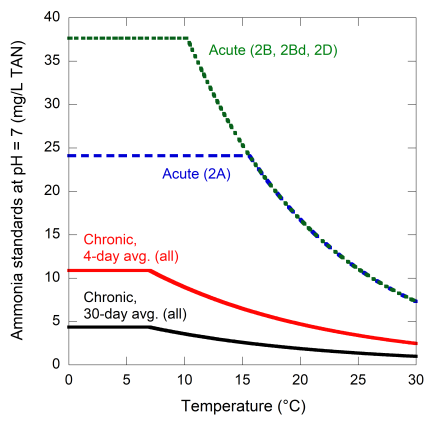The MPCA proposes to adopt the U.S. EPA's 2013 national recommended water quality criteria for ammonia as its Class 2 ammonia water quality standards for the protection of aquatic life. Such adoption will bring Minnesota’s standards into alignment with current scientific understanding on the sensitivity of freshwater mussels, snails, coldwater fish, and other organisms to ammonia in the aquatic environment. Adoption of EPA national criteria entails revising an existing 4-day chronic standard, adding a new 30-day chronic standard, and adding new acute standards. Each standard is expressed in terms of total ammonia nitrogen (TAN), defined as the sum of un-ionized ammonia (NH3) and ionized ammonium (NH4+).
The proposed standards are not presented as single, fixed numeric values. Rather, they are each composed of a set of numeric values generated from equations, which reflect an understanding that the sensitivity of aquatic organisms to ammonia depends upon the pH and temperature of the water. At any particular pH value, the applicable ammonia standards increase as temperature declines, until reaching a plateau at specific temperature thresholds (see figure for example). Refer to these resources for more information about the rationale behind these equation-based standards:
Ammonia standards calculator tool
To determine the acute and chronic ammonia standards that are applicable to your waters, try using this standard calculator tool:
You will need to enter the pH and temperature of the water body (lake, river, stream, or wetland) into the calculator. Tables located within the technical support document or EPA water quality criteria recommendations can also be used to look up numeric values.
These calculated values are water quality standards, not wastewater effluent limits. More information about the anticipated effects of the proposed ammonia water quality standards on wastewater effluent limits will be provided during the rulemaking process.

Example
At a pH of 7 and temperature of 20°C, the following standard values apply:
- Acute (Class 2A): 17 mg/L - This category includes coldwater habitats
- Acute (Classes 2B, 2Bd, 2D): 17 mg/L - This category includes cool and warm water habitats as well as wetlands
- Chronic, 30-day average (all classes): 1.9 mg/L
- Chronic, 4-day average (all classes): 4.8 mg/L